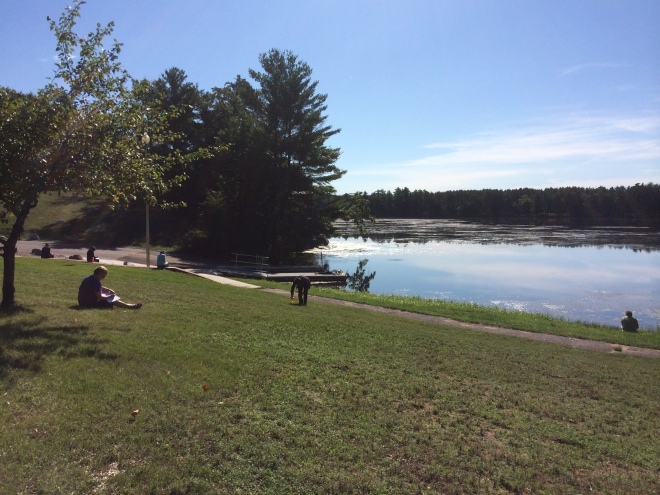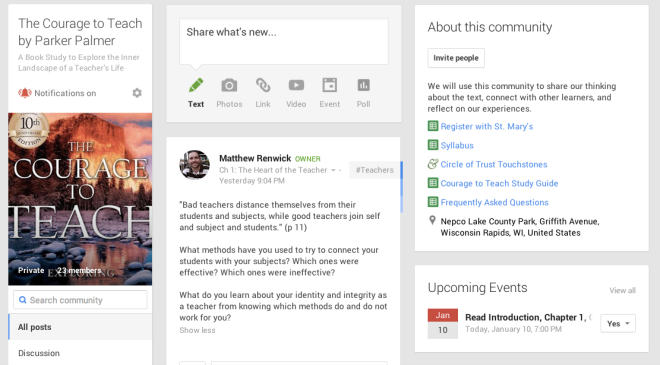Unlearning is more difficult than learning something new, and one of our most important challenges is to let go of existing structures in order to build more effective ones. – Alan November, from his book Who Owns the Learning? Preparing Students for Success in the Digital Age (Solution Tree, 2012)
Hybrid Classes Outlearn Traditional Classes by Dian Scaffhauser (T|H|E Journal, December 18, 2014)
Schaffhauser summarizes a 2013-2014 study on the impact of blended learning for over 8,000 Pennsylvannia students. Over 90% of schools that implemented hybrid classes saw “higher academic performance on standardized tests compared to traditional classrooms”. The organization that facilitated implementation and conducted the study, Hybrid Learning Institute, defines blended learning through six characteristics:
- The use of a blended classroom system;
- Students rotate among different learning stations;
- Instruction is delivered in small groups;
- Students take frequent digital assessments;
- Educators use student information to differentiate instruction; and
- The personalized learning is considered “cost-effective.”
What Else Should KIPP Be Doing With Blended Learning? by Michael B. Horn (Forbes, November 20, 2014)
The co-author of Blended: Using Disruptive Innovation to Improve Schools highlights this well-known charter school network’s attempts at blended learning. He applauds the organization’s focus on “addressing their core problems with sustaining models of blended learning”, such as students rotating among learning stations.
Horn also encourages KIPP leaders to explore disruptive models. This is increasingly important for students who have no access to essential learning courses, referred to as “nonconsumption opportunities”. An example would be inner city schools that cannot hire highly qualified math and science teachers. Online courses would be one solution.
Blended Learning for Early Learners by Mary Evans, Jennifer Hawkins, and Patrice McCrary (Principal, November/December 2014)
“Imagine a classroom so engaging that students thought they were playing all day – and learning science, social studies, math, and language in the process.” The authors, a principal and two preschool teachers respectively, offer this promise for personalized learning. Through their work in an elementary school in Kentucky, they have found that this method of instruction successfully “integrates online activities with traditional face-to-face classroom instruction”.
They highlight several benefits that blended learning can provide for students: a lower student/teacher ratio (due to rotations), targeted instruction using real time assessments, and an opportunity to “prepare students for complex, technology-enhanced instruction”. For schools to get started, Evans, Hawkins, and McCrary suggest leaders recruit interested teachers, provide adequate training and resources, and connect building experts with teachers new to this concept.
Check out EDvite and how to connect learning to community:
[kickstarter url=http://www.kickstarter.com/projects/1510286564/edvite-an-app-that-connects-students-to-community width=480]
(site sponsor)
Teacher as Trickster: Navigating Boundaries into Blended Transformational Spaces by Jeffrey D. Wilhelm (Voices from the Middle, December 2014)
Dr. Wilhelm, Professor of English Education at Boise State University, draws on mythology to compare rule-breakers found in this genre (“tricksters”) with today’s teachers using blended learning. They develop an environment “that uses a variety of tools – digital, artistic, problem-solving, etc. – for the purpose of solving new problems, creating new conversation turns, composing new knowledge artifacts, and of seeing and beginning to inhabit, at least tentatively, new possible worlds beyond those that are current actualized.”
This combination of in-person and virtual learning can create what is referred to as “a third space”, defined as “places that are neither traditionally school nor home, but places of unprecedented possibility”. It is in this combination that students are better able to make connections with others, and to pursue their inquiries to develop products and new understandings. “In this process, students create new ways of seeing and being.”
What Students Do (And Don’t Do) In Khan Academy by Dan Meyer (dy/dan, December 4, 2014)
Dan Meyer, a mathematics teacher, studied the online tutorial system Khan Academy for his dissertation. He set out to answer two questions: What are students asked to do? and What do students produce? After completing 88 practice sets, Meyer found that the majority of math problems in Khan Academy expect students to produce a single answer via multiple choice. He concluded that Khan is not closely aligned with the type of mathematical thinking that students are expected to display, such as making an argument to support a solution to a complex problem.
Related, I highly recommend viewing Dan Meyer’s TED Talk about mathematics instruction. It has been viewed almost two million times.
[ted id=855]
Putting it into practice…
The beginning image documents the staff retreat my school took part in last fall. We congregated at an enclosed park shelter with two education consultants, who led us to explore why we went into teaching and to help us reflect on our professional lives. Afterward, both the consultants and some of the staff expressed interest in continuing to discuss the ideas from our time together, based on the book The Courage to Teach by Parker J. Palmer.
Because time to physically meet is difficult during the school year, we set up a Google+ Community to discuss the book as we read it. We share our thinking for each chapter from the comfort of our own homes, when time allows. This has been welcomed, especially when the temperatures drop below zero here in Central Wisconsin. We answer important questions, write about our experiences, and positively acknowledge each others’ responses.
It wasn’t until I read Jeff Wilhelm’s article that I realized that we were engaged in a deep form of blended learning. Once we have finished The Courage to Teach, we will come back to the park and shelter on the first day of spring. We have created our own “third space”, balancing online and in-person experiences to create something possibly greater than either setting could provide alone.
I compare this set up to what some of the previous articles prescribe for how blended learning should function in today’s schools. What’s missing? I asked myself. Then it came to me: Connectedness. This is not the same as being connected, such as an online course. It is a concept that Parker Palmer defines as the ability of teachers to “weave a complex web of connections among themselves, their subjects, and their students so that students can learn to weave a world for themselves” (65).
Not there isn’t a need for skill and knowledge development through a more formal blended learning environment. Dan Meyer acknowledges this, in spite of his findings. But if lab rotations and real time assessments are all that blended learning can be, then we have failed to use these digital tools to their fullest capacity. As Alan November would ask, Who owns the learning? Certainly not the students.
I believe that for education to fully realize technology’s potential in schools, we have to create these third spaces of learning for students and for ourselves. It may not happen all the time. This type of learning is not as easy to assess. More preparation may be required on the part of the teacher. But if we can develop a sense of connectedness from these rich and blended experiences, wouldn’t it be worth it?


9 responses to “BlendEd”
Reblogged this on Reading By Example and commented:
Technology is becoming ubiquitous. With all of this access, how can we start to develop authentic spaces for learning that complement and enhance our in-person learning experiences? I explore different interpretations of blended learning, as well as offer my own thoughts on how to best help learners come together and develop a sense of connectedness with their peers, their subject, and themselves.
Reblogged this on careabouteducation and commented:
Nice info. Thanks
Matt, once again thank you for sharing some very thought provoking articles and your own personal views. I am a teacher in Pennsylvania so the first article was interesting to me. We are in the process of transitioning all classrooms in grades 4-12 to an one-to-one model. While my district was not part of the study in the article, I can’t help but to wonder how we would compare.
Wow, that sounds exciting. I’m sure people would love to read more about the process and your thinking on it. When the time is right for this initiative, would you be interested in writing a guest post for Theory and Practice on this topic and your experiences?
Yes! That would be great. I am in a 4-6 building and our initiative is to begin next year. They already completed the one-to-one in grades 7-12. We are excited and nervous at the same time.
That sounds great, Amy. When you are ready, just submit your information here (http://mattrenwick.com/about/) and we can take it from there.
Take care,
Matt
Matt,
Just reading this now. I’m not yet convinced about “blended learning”, the latest “new” idea. I do very much like what you and your teachers are doing with your Google Community set up for book discussion. Makes good sense.
Warm regards, Regie
Thank you Regie. The Google Community has been a nice way to connect in between face-to-face meetings.
[…] to better connect with other professionals. Ware offers clear guidelines for these third spaces for […]